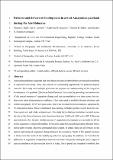Patterns and drivers of development in a west Amazonian peatland during the late Holocene
Abstract
Amazonian peatlands sequester and store large amounts of carbon below ground and contribute to regional biodiversity. They also present an outstanding opportunity for palaeoecological research. This study uses multiple peat cores to improve our understanding of the long-term development of a peatland (Quistococha) in Peruvian Amazonia, by providing a reconstruction of the spatial patterns of vegetation change and peat accumulation over time across the site. Peat cores taken along transects totalling c. 5 km were used to establish the peat thickness and visible stratigraphy. Of 29 new peat cores, four were selected for pollen analysis, supported by 15 radiocarbon dates. These complement two existing published pollen records from the site, from a peat core and a lake sediment core. Our study shows that peat initiation occurred across the site in the form of primary mire formation between 2400 and 1900 cal yr BP. Following peat initiation, five broadly similar phases of vegetation development are recorded in all the pollen sequences: Amazon floodplain, herbaceous sedge fen, mixed angiosperm flooded forest, mixed palm swamp, Mauritia-dominated palm swamp. In detail, there are differences in the pattern and timing of vegetation change between the sequences. Much of this spatial variation is likely to be the result of the underlying substrate topography. In addition, we find that the difference in vegetation composition between core sites was greater during the early stages of peat accumulation at Quistococha than it is today. Such spatial and temporal variability has significant implications for computer modelling of carbon accumulation in tropical peatlands and, consequently, our understanding of their role in the global carbon cycle. Our findings highlight key challenges for numerical modelling on Holocene timescales, namely the difficulty in quantifying long-term variations in primary productivity, the variable influence of sediment input on carbon accumulation during the early stages of peatland formation, and the difficulty of modelling water tables in sites with variable underlying topography.
Citation
Kelly , T , Lawson , I T , Roucoux , K H , Baker , T & Honorio Coronado , E 2020 , ' Patterns and drivers of development in a west Amazonian peatland during the late Holocene ' , Quaternary Science Reviews , vol. 230 , 106168 . https://doi.org/10.1016/j.quascirev.2020.106168
Publication
Quaternary Science Reviews
Status
Peer reviewed
ISSN
0277-3791Type
Journal article
Description
We gratefully acknowledge financial support from the Royal Geographical Society, and NERC (grant ref. NE/H011773/1 and a quota PhD studentship), including two radiocarbon allocations (refs. 1612.0312, 1558.0411).Collections
Items in the St Andrews Research Repository are protected by copyright, with all rights reserved, unless otherwise indicated.

